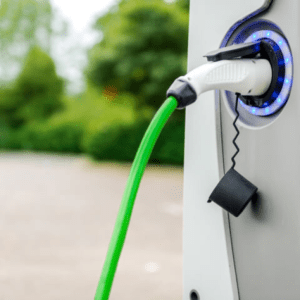Home charging stations have become increasingly common as more people opt to upgrade to electric vehicles (EV). By charging their EVs at home, people can avoid needing to stop at public charging stations. It is an easy way of ensuring your vehicle is powered up for its next journey when you need to hit the road. Most will plug in when they get home, timing the vehicle for overnight charging when power tariffs are lowest. This is convenient and cost-saving.
However, charging an EV is not without some pitfalls. There is a cable that connects the vehicle to an outlet or home charging station. Under ideal circumstances, an EV owner would have their own driveway or garage. Here they would be able to install an easily accessible home charging point and be plug in their cable without a worry.
For those that however park on the street, there are other pedestrians to contend with. People are entitled to make use of kerbs without encumbrance or risk of injury. Having a charging cable run from the house, across the pavement, and into the EV is problematic. Let’s address some of the concerns EV owners might about this and related issues.
How Does an EV Cable Become a Trip Hazard?
As said, anyone charging their EV while it on the street would have to run the cable across the pavement to get to their car. Never do this when the vehicle is across the street. You should always park on the same side as the property you are charging from.
It is advisable to try and lay the cable flat against the ground. However, even with this, anything can happen to cause the cable to come loose and increase the risk of someone tripping. Even lying flat, these cables are not always visually noticeable and those that step on them may become unbalanced and fall.
What Other Danger Is There from Charging My Car On the Street?
Being a trip hazard is bad enough. The situation can, however, become worse if you do not take suitable care of your cable. Wear and tear are normal given that the cable is subjected to a lot of movement, including dragging along the ground and is exposed to whatever weather changes of the day. Though built to endure tough outdoor conditions, these cables can eventually become worn enough to expose the wiring. Wiring can also be made bare in cases of vandalism or theft.
Residual Current Device (RCD) breaker technology does a good job of preventing electrocution should the cable be damaged and exposed to wet conditions. But even this has a minor risk of failing, making it vital to find a means of ensuring no pedestrian or animal walking along the kerb comes in contact with your cable.
How Can I Prevent My EV Cable Being a Trip Hazard?
We highly recommend the use of cable protectors. These devices are often seen in use at public events where cables for electricity and sound have to be channelled all over. Their design ensures that people can safely walk over the cable without damaging it or hurting themselves. They are typically non-slip and have bright markings, mostly yellow, that make them visible under even low-light conditions. You will need to get cable protectors that can cover the area from your property boundary to the end of the kerb or vehicle.
Ensure that at no point until you come to the vehicle does the cable rise up. That means you should be running the cable from the ground floor of the property, not an upper floor.
For those that do park in their own driveway, be strategic in where you place your charging point. Let it not be in the way of people that make deliveries or are visiting. Ensure the cable runs along an area that is unlikely to have people unknowing pass over it and possibly trip.
Also, avoid leaving your charging cable out on the pavement when not in use. The less time it spends exposed, the lower the chances of it being a trip hazard. Because most charging takes place at night when fewer people are moving about, the risks reduce even more. Do invest in a wall hook or holder on which to hang your cable when not in use. Something similar to how fire hoses are hung up.
Also, with on-street parking, be sure to inform your home insurance provider about the change. Having a ev cable run across the pavement and someone being injured could result in a claim. Take necessary precautions against this risk and ensure you are properly covered to avoid the risk of a financial hit.






